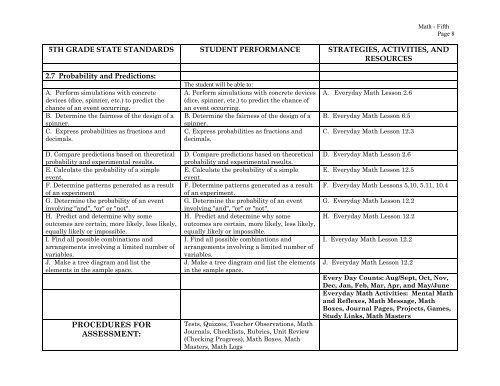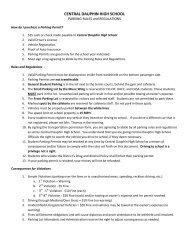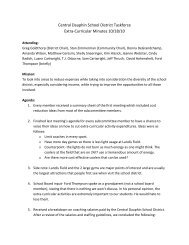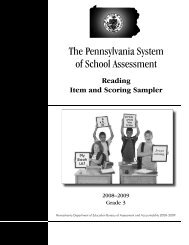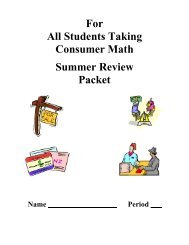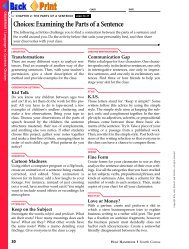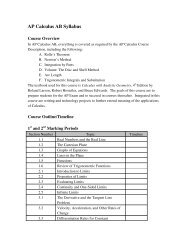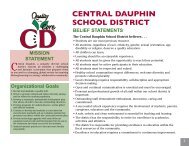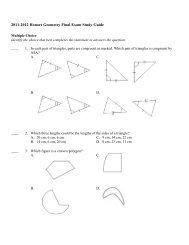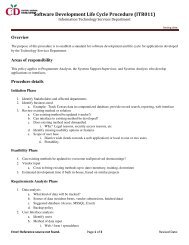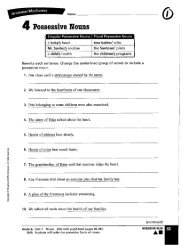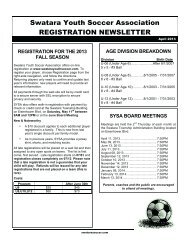Course Title: Math Grade Level: Fifth
Course Title: Math Grade Level: Fifth
Course Title: Math Grade Level: Fifth
You also want an ePaper? Increase the reach of your titles
YUMPU automatically turns print PDFs into web optimized ePapers that Google loves.
<strong>Math</strong> - <strong>Fifth</strong><br />
Page 8<br />
5TH GRADE STATE STANDARDS STUDENT PERFORMANCE STRATEGIES, ACTIVITIES, AND<br />
RESOURCES<br />
2.7 Probability and Predictions:<br />
A. Perform simulations with concrete<br />
devices (dice, spinner, etc.) to predict the<br />
chance of an event occurring.<br />
B. Determine the fairness of the design of a<br />
spinner.<br />
C. Express probabilities as fractions and<br />
decimals.<br />
D. Compare predictions based on theoretical<br />
probability and experimental results.<br />
E. Calculate the probability of a simple<br />
event.<br />
F. Determine patterns generated as a result<br />
of an experiment<br />
G. Determine the probability of an event<br />
involving "and", "or" or "not".<br />
H. Predict and determine why some<br />
outcomes are certain, more likely, less likely,<br />
equally likely or impossible.<br />
I. Find all possible combinations and<br />
arrangements involving a limited number of<br />
variables.<br />
J. Make a tree diagram and list the<br />
elements in the sample space.<br />
PROCEDURES FOR<br />
ASSESSMENT:<br />
The student will be able to:<br />
A. Perform simulations with concrete devices<br />
(dice, spinner, etc.) to predict the chance of<br />
an event occurring.<br />
B. Determine the fairness of the design of a<br />
spinner.<br />
C. Express probabilities as fractions and<br />
decimals.<br />
D. Compare predictions based on theoretical<br />
probability and experimental results.<br />
E. Calculate the probability of a simple<br />
event.<br />
F. Determine patterns generated as a result<br />
of an experiment.<br />
G. Determine the probability of an event<br />
involving "and", "or" or "not".<br />
H. Predict and determine why some<br />
outcomes are certain, more likely, less likely,<br />
equally likely or impossible.<br />
I. Find all possible combinations and<br />
arrangements involving a limited number of<br />
variables.<br />
J. Make a tree diagram and list the elements<br />
in the sample space.<br />
Tests, Quizzes, Teacher Observations, <strong>Math</strong><br />
Journals, Checklists, Rubrics, Unit Review<br />
(Checking Progress), <strong>Math</strong> Boxes, <strong>Math</strong><br />
Masters, <strong>Math</strong> Logs<br />
A. Everyday <strong>Math</strong> Lesson 2.6<br />
B. Everyday <strong>Math</strong> Lesson 6.5<br />
C. Everyday <strong>Math</strong> Lesson 12.3<br />
D. Everyday <strong>Math</strong> Lesson 2.6<br />
E. Everyday <strong>Math</strong> Lesson 12.5<br />
F. Everyday <strong>Math</strong> Lessons 5.10, 5.11, 10.4<br />
G. Everyday <strong>Math</strong> Lesson 12.2<br />
H. Everyday <strong>Math</strong> Lesson 12.2<br />
I. Everyday <strong>Math</strong> Lesson 12.2<br />
J. Everyday <strong>Math</strong> Lesson 12.2<br />
Every Day Counts: Aug/Sept, Oct, Nov,<br />
Dec, Jan, Feb, Mar, Apr, and May/June<br />
Everyday <strong>Math</strong> Activities: Mental <strong>Math</strong><br />
and Reflexes, <strong>Math</strong> Message, <strong>Math</strong><br />
Boxes, Journal Pages, Projects, Games,<br />
Study Links, <strong>Math</strong> Masters


